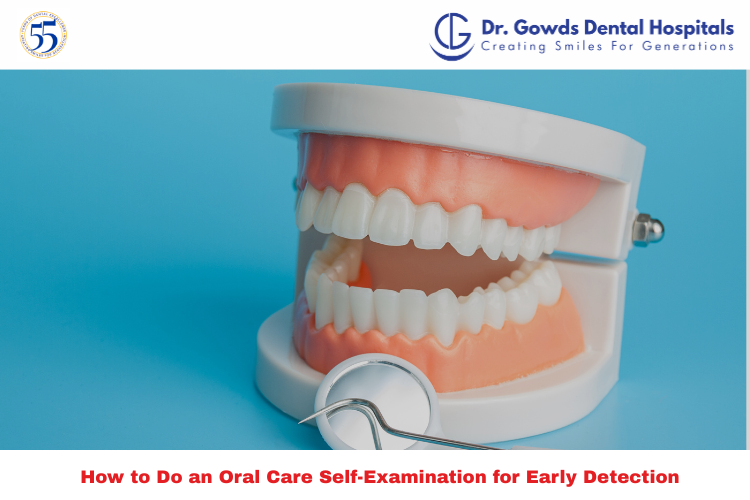Schedule Appointment




When was the last time you actually had a look in your mouth other than just brushing? If your response is, “I don’t know,” you are definitely like a lot of other people. Most people go only to the dentist twice a year, and they think that it is enough to find any problems with their mouth. However, quite often, this is not the case. In fact, no blood test for oral cancer was performed during that period between check-ups, and thus, oral cancer, in particular, may develop quietly.
That is why a personal care practice of the oral cavity performed once a month can have a beneficial effect upon the entire system. You don’t need to have special equipment. Only a good mirror, light, and a ten-minute long period of concentration are necessary.
Let’s look through the steps to be taken to perform the examination together: how, why, when, and what the warning signs of the problem are.
This communication is similar to your usual interactions with your physician. You aren’t the dentist’s replacement. Instead, you will be the first person to be responsible for your health. Oral care self-examination is a quick, organized inspection of your oral cavity through external visual and physical means looking for abnormalities.
This includes checking for the presence of occlusions, welts, and teeth, feeling around the lips, cheeks, gums, tongue, palate, and the neck, and even the jawline. The most essential thing is to discover the early stage of the process that leads to the occurrence of the first signs of infections, inflammations, lesions, or the most problematic cadence of cells, namely, cancerous.
If you detect oral cancer in its early stage, your chances of getting cured are high. However, a great number of cases are diagnosed at an advanced stage. Oral care self-examinations are the best way to be observant of any minor adjustments that may be symptoms of the disease.
Pain is not always present in the early stages of oral health problems. The reason why you should observe changes, and not only feel them, is that finding changes is crucial for different diseases
Considering that a dental visit takes place every half of a year, there still are more than 300 days between the appointments. A short and simple monthly self-assessment can help minimize such void.
You do not need to have a medical degree to carry out this. But, all you need is a regular check-up, a little bit of curiosity and your health awareness.
Lift your chin and look at your neck and face in the mirror. Do you recognize:
If you find anything unusual, make sure to inform the doctor about it.
Check the inside and outside of the lips by retracting them and look at them. After that, do the same for your cheeks. Identify what the changes are:
Put your lips up and down to be able to see the gums. While observing, be sure to let the three words known to you be your guide.
Extend it. Shake it from one side to the other. Examine it again. Areas you need to be aware of:
If you want, take a piece of tissue or gauze to hold your tongue comfortably and see the entire view.
Put your head back a little. Check the roof of your mouth up and down with your mouth wide open. Lower your tongue down to see the floor of your mouth.
What to Look for:
Open your mouth and look at the picture. Investigate for:
If nothing seems regular, and you still have a feeling of uneasiness, then do not waste your time anymore and call your dentist or doctor.
An indication of oral cancer or severe infections. Timely treatment is of great importance.
Just once a month. That’s all. Relate it to a habit — like changing your toothbrush or the first weekend of every month — and it becomes easy.
Moreover, even if you have nothing, you are establishing consciousness of your personal baseline, so any new changes will stand out right away.
Oral care self-examinations should practically be a must for everyone, but it is even more so if you are:
Low nutrient products, regular alcohol consumption, tobacco, and the like increase the threat of oral health risks; hence, monthly self-checks are a necessity.
| Self-Exam | Dental Checkup |
| Monthly | Every 6 months (or as needed) |
| Helps spot early changes | Offers professional diagnosis |
| Inexpensive and quick | May include x-rays and lab tests |
| Empowers daily awareness | Enables treatment and cleanings |
Together, they form the strongest defense for your dental health.
Although you cannot do a final diagnosis, you can detect the first symptoms to the doctor’s attention early.
Approximately 10 minutes. This is only a small investment of your time, it may even save your life.
The recommended age is 12 years old and up. Younger children may not be ready to perform self-examination, but their parents can help or simply monitor changes.
Make a photo and on the same day of next month, check it. Alternatively, show it to your dentist.
Without a doubt. This is not a substitution, it acts as a completion to your dental checkups.
Your mouth is the window to the health of your body – and also shows whether you are looking at all. The simple arrangement of a monthly routine in the practice of oral care self-examination will enable you to take stock, raise your consciousness and look after your longer lifespan.
Book a visit to Dr. Gowds Dental Hospital.